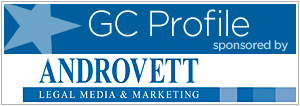© 2017 The Texas Lawbook.

By Mark Curriden
(May 16) – An East Texas jury hit AT&T with an unprecedented $156 million verdict in 2007 for willfully violating patents regarding the processing of telephone calling cards.
A federal judge later overturned the judgment because the evidence did not support the verdict, but the litigation dam had broken and intellectual property lawsuits started piling up. Scores of individuals, businesses and institutions sued AT&T, claiming the Dallas telecommunications giant had violated their patented technology.
Patent infringement lawsuits throughout the U.S. quadrupled during the past seven years – many of them targeting the major wireless phone and Internet businesses. AT&T was one of the nation’s most frequent targets. In fact, Fortune magazine named AT&T as the favorite defendant of so-called patent trolls in 2013.

AT&T General Counsel David McAtee says at any given time the company faces a dozen or more patent infringement lawsuits in federal courts across the country. Each case seeks anywhere from a few million dollars to several hundred million.
In addition, AT&T also “owns a huge portfolio of patents that we need to protect and enforce” – patents that are literally valued in the billions of dollars, McAtee says.
“We realized that our approach to patent litigation had to change and had to become more sophisticated,” he says.
To address the growing threat, McAtee and Berinhout created a specialized group within its corporate legal department to focus exclusively on patent infringement litigation. They hired five experienced IP trial lawyers who also have engineering and computer science backgrounds.
Berinhout says the mission of the new internal patent trial team is twofold: “To enhance our effectiveness in defending against this litigation and to reduce the attractiveness of AT&T as a target of this litigation,” he says.
The AT&T patent specialty team handles the case from start to finish, including selecting the best outside law firm to do lead the litigation.
“It was vital to the mission that we be prepared to try every case and that we convey that sense, that determination and that competence to our adversaries,” Berinhout says. “We looked for lawyers who knew how to take a very complex patent and explain it to a judge who may not be trained in engineering or science, and also to a lay jury.”
McAtee’s and Berinhout’s first hire in creating the team was Brian Gaffney, who was an experienced patent trial lawyer at Baker Botts for nearly a decade.

“We approach each case against us as if it has merit and we treat it as such,” Gaffney says. “We look at every case from day one as if it is going to trial.
“This principle is very important,” he says. “Because AT&T is such a target for these type of lawsuits, we believe it is important that we demonstrate as a company that we are willing to vigorously prepare and defend each one of these cases and that we are willing to take each one of these cases to trial if necessary.”
Berinhout and Gaffney say that the AT&T team participates in every step of the case.
“We are deeply involved in every aspect of every decision made in our cases,” Gaffney says. “We want to understand the basis for every decision and every recommendation [that our outside lawyers] are making to us. If you ask our outside counsel about our involvement on a scale of one to 10, we are an 11.”
The patent litigation team engages AT&T in-house corporate lawyers in various business sections for assistance in helping understand the technology and how the company uses it.
“We even take it a step further,” Berinhout says. “As we start to look toward trial, we bring in an additional in-house litigation lawyer who concentrates on the appellate aspects of a case, anticipating the possibility that we will be the appellee if we win in the trial court or the appellant if we lose in the trial court.
“By bringing that appellate lawyer in at an early stage, it helps assure that the moves and arguments we make in the trial court also set up for success in the appellate court,” he says.
Gaffney and Berinhout say that AT&T has experienced extraordinary success in getting cases dismissed since forming the new team.
“We get dismissed in more cases for zero dollars than we do paying money to settle,” Gaffney says.
Two huge courtroom successes came in 2015 in cases that many predicted would end in significant damages.
In August 2015, a Los Angeles jury, after an intense eight-day trial in which tens of millions of dollars were at stake, ruled unanimously that AT&T did not infringe two patents held by Enovsys. The jury also invalidated several other patents. The U.S. Court of Appeals for the Federal Circuit upheld the jury’s decision in March and denied a request to reconsider this past Thursday.
Four months later, AT&T went to trial in a case brought by 4G developer Adaptix, which claimed AT&T Mobility and several other companies unlawfully employed their technology without a licensing agreement. In a complete victory for AT&T, a Texas jury ruled that Adaptix’s patents were invalid and that there was no infringement.
“The AT&T patent lawyers are actual experts in their field and are more engaged in their cases than any in-house lawyers I have ever seen,” says Baker Botts partner Bryant C. Boren, who has represented AT&T in IP cases for more than a decade.
AT&T in-house lawyers are “partners on the litigation team without being micromanagers,” says Tim Durst, a Baker Botts partner who has worked with Berinhout and Gaffney on multiple matters.
Durst and Boren say the case against Enovsys in California is a perfect example.
“The AT&T lawyer was up all night with us during the trial working on strategy and trial preparation,” Boren says. “It is very collaborative from start to finish.”
Berinhout says their work with outside counsel is a true partnership.
“This team of in-house lawyers could not possibly handle all of the defense of the patent litigation that we have to mount,” he says. “Virtually every case, we team up with some of the best patent infringement lawyers in Dallas and across the U.S.”
Berinhout says the company’s outside counsel has, for the most part, been very receptive to the AT&T patent team.
“An outside lawyer who doesn’t welcome this won’t remain our outside lawyer for very long,” he says. “There are some outside lawyers who are uncomfortable with in-house lawyers having the kind of involvement we have. For the most part, the lawyers we work with really welcome our role. We form real partnerships. That improves our performance and their performance.
“I spent many years at a law firm and I can tell you that I never encountered in-house lawyers who were as close to involved or integrated with the trial team as we are here at AT&T,” Berinhout says. “Our in-house lawyers are not there to observe, but to lead the strategy. Our lawyers help prepare witnesses for trial and even present witnesses. We are a very engaged group.”
Berinhout says AT&T’s strategy is seeing results.
“We have seen a marked decrease in the number of patent cases we face,” he says. “Some of that is attributed to nationwide trends and changes in the law.
“But we also believe that conveying to plaintiff’s bar and to the same lawyers we see over and over again that we will fight cases makes us a less attractive target, especially for patent trolls and for those who have weaker cases,” Berinhout says. “They are less likely to roll the dice on us then they would be if we were an easier mark.”
© 2017 The Texas Lawbook. Content of The Texas Lawbook is controlled and protected by specific licensing agreements with our subscribers and under federal copyright laws. Any distribution of this content without the consent of The Texas Lawbook is prohibited.
If you see any inaccuracy in any article in The Texas Lawbook, please contact us. Our goal is content that is 100% true and accurate. Thank you.
